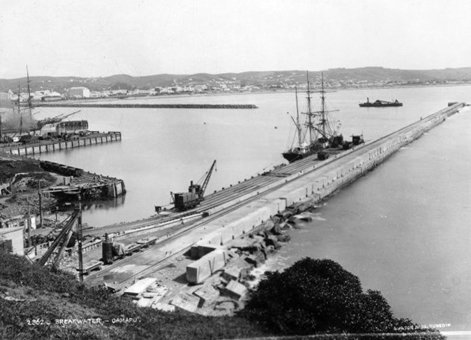John McGregor was born in Fife, Scotland, and trained there as a harbour engineer.

View of the breakwater extending into the Oamaru harbour. Ref; 1/2 C-22767-F, Alexander Turnbull Library, Wellington, New Zealand.
The date of his arrival in New Zealand is uncertain, but he was assistant to James Melville Balfour (1831–1869) on the Ross Creek reservoir from June 1866 until its completion in November 1867.
McGregor was then employed by the Harbour Board of Port Chalmers and became the Oamaru Harbour Trust’s Engineer on 5 March 1870. It should be noted McGregor was not a salaried officer of the Oamaru Dock Trust or its successor, the Harbour Board, but was engaged to design and carry out harbour works on the basis of receiving 2.5 per cent of the moneys expended on works. Harbour improvements were important at Oamaru; for example, seven vessels were shipwrecked attempting to load or unload at Oamaru in 1873. Between 1860 and 1875 33 vessels were driven ashore, of which 20 became total losses.
McGregor very soon decided to include a breakwater as the major factor in the harbour’s design. Work was started in 1871 and the first block was laid on 10 September 1872. Progress was slow on Oamaru’s breakwater. In 1874 McGregor reported that of the 300 feet of breakwater was completed, 63 feet had been created that year. He estimated future progress at 350 feet per annum.
Meanwhile he was busy elsewhere. For a time after 30 April 1872 McGregor was assisting Charles Napier Bell (1835–1906) locating deviations on railway Waitaki to Moeraki at £10 per week. That year he also reported on a dredging scheme for Otago Harbour and also on Balfour's central training wall proposal.
In 1873 he reported on harbour works for Napier and designed a breakwater harbour. He made another report on Napier in 1875 to much the same effect. The work was not proceeded with, but eventually a breakwater was constructed in a different position to McGregor’s proposed one.
He surveyed the railway up the Waihao Valley in 1874. McGregor had previously offered to build the line of railway himself and to take payment in land. He already held 15,000 acres in the area to be served. When his offer was refused he proposed doing the engineering survey at £30 per mile, and this was accepted. McGregor may have been paid for and supervised the field work, but did not personally carry it.
In 1875 McGregor was evidently concerned with the question of Oamaru’s water supply because in June 1875 the Government analyst at Dunedin produced a report on the character of the Waitaki River’s water based on samples sent by McGregor. Possibly he was assisting Forrester, who completed a design for this scheme.
Meanwhile, by April 1879 1,000 feet of breakwater had been constructed and a further contract for 700 feet was let to Miller and Smillie. The breakwater was completed in February 1884.
In 1879 Forrester, who in addition to being Clerk of Works to the Harbour Board, was also an architect, had borings made in the bed of the sea under the shelter of the breakwater, and these disclosed that the bottom was readily dredgeable. The harbour scheme was at once elaborated and instead of simply making quiet water in which vessels at anchor could work cargo under the shelter of the breakwater, it was decided an enclosed harbour with deep water wharves was possible, desirable and justifiable. This involved a northern mole 1,800 feet in length, three wharves and the purchase of a dredge. The northern mole was not started until 1881 owing to the first contractor failing.
In 1885 McGregor was appointed Harbour Engineer at Auckland. During his term a comprehensive scheme of improvements estimated to cost £1,167,000 was prepared, and it is interesting to note that the present waterfront railway was envisaged. He also built the Hobson Wharf and the Quay Street jetty. McGregor held this position until 1888, when the adverse economic situation led to the Board’s decision to do without an engineer.
He then seems to have turned to mining engineering, being a battery manager in 1900. McGregor died in Reefton on 1 September 1911.
Find out more
Source
Frederick Furkert, Early New Zealand Engineers (Wellington: Reed, 1953), p.213.
